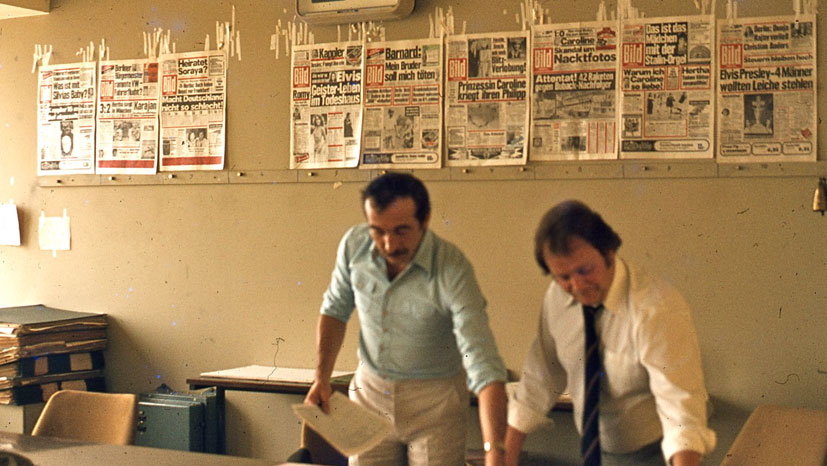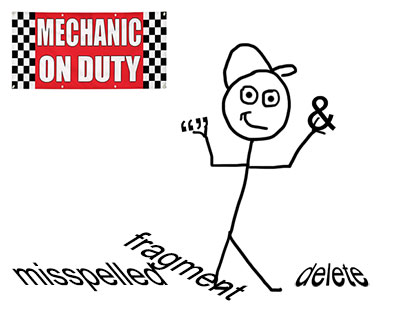
As editors, we often speak of “cleaning up” a document. But it’s not like going through the car wash, where every vehicle gets the same treatment. The rules of spelling, punctuation, and grammar remain constant, sure, and the end goal of clarity stays the same from project to project. The editing process, though, is different every time. Editors respond to conditions as we find them. Our approach to a given document depends on the nature of the problems found within. We’re like mechanics; our job is to diagnose as well as to repair.

I’ve spent most of this month editing a manuscript by a first-time novelist. That’s not terribly unusual in itself. Although most of ProofreadingPal’s projects are academic works, we get a good deal of creative writing as well. It was curious, though, that this was my second read-through of this particular manuscript.
Get a free sample proofread and edit for your English document.
Two professional proofreaders will proofread and edit your English document.
This first came about six months ago, with what was obviously a first draft. I addressed spelling and punctuation and did some basic fact-checking. But most of my effort went into actually teaching the fundamentals of fiction writing: identifying the proper starting and ending points of the story, handling exposition, maintaining a consistent point of view, crafting believable dialogue, and other basics. I labored over the manuscript for weeks, leaving dozens of notes (some nearly as long as this blog entry!) and always emphasized the same basic message: There is an engaging story here, with colorful, likable characters, which must be thoroughly rewritten to meet even a basic standard of readability.
When the latest draft hit my desktop, I saw that the author had incorporated many of my revisions, even cutting whole chapters at my suggestion. The story now moved like a rocket, never losing focus despite the large cast of characters. I flew through my editing pass in a matter of days; there were a few lingering story issues to resolve, but the bulk of the task was a simple once-over for punctuation and syntax errors.
Reading over the finished product, I was delighted. And yet I could not help but think of the cost. It took two full professional edits, each at full price, to bring the manuscript to this point. Now, I’m confident that this particular client got their money’s worth, and then some. But with quality professional editing being so expensive, how can you be sure you’re getting the most for your money?
Mostly, it comes down to making a fearless assessment of your own work. Sometimes all a document needs is a sweep for typos. Often, there are technical or organizational problems to address, and only then, after the structural issues and mechanical flaws are repaired, is the document ready for cleanup.
Bear in mind, it’s got to happen in that order: the big problems first, then the smaller ones, then the surfaces. There’s no point in doing it any other way. If your document is confusingly written or your meaning is unclear, correcting the punctuation and spelling doesn’t actually fix anything, any more than a wash-and-wax job will make a car run if the engine’s been removed.
And yet a surprisingly high number of clients attempt to do the process backwards, sending us documents fully formatted for printing that have never been viewed by any eyes but the author’s. Great care has gone into the choice of typeface and graphics, and the page breaks are all just so, never mind that the actual writing may be barely coherent. They’ve polished that wreck to a high gloss, but it’s not going anywhere until we tear it apart and build it back up again.
Getting the most out of proofreading, then, entails making sure your document is as good as you can make it before submission.
A paid proofreader should never be your first audience.
Consider joining a writing group, or show your work to a colleague, a trusted friend, or a teacher. The feedback you’ll get may not be as specific or as useful as a professional critique, but even a comment like, “I didn’t understand the ending,” can point you toward identifying the weaknesses in your own work.
Learn as much as you can. You don’t need a college degree in creative writing, but a couple of courses at your local community center might be a worthwhile investment. The most important thing you can do on your own to become a better writer, however, is to become a better reader. Read widely; go outside your usual areas of interest. Study literary criticism to learn how to read analytically, and apply that skill to your own writing.
In the end, it’s simply a matter of work. A professional edit is not a shortcut to quality writing; that comes only from rewriting, and that job is yours alone. The more you revise a piece before proofreading, the less you’ll need to revise it afterward. A talented and sympathetic editor will always leave your work better than they found it, but it’s unwise to rely on an editor or proofreader to fix your work.
Aim to bring a copy editor into the process as late in the game as possible and only after you are satisfied that you have fixed any problems with the piece to the best of your ability. The higher the quality of the work coming into the editing process, the better the result and the greater the value you’ll get for your money.
Jack F.
Get a free sample proofread and edit for your English document.
Two professional proofreaders will proofread and edit your English document.
Get a free sample proofread and edit for your document.
Two professional proofreaders will proofread and edit your document.
We will get your free sample back in three to six hours!